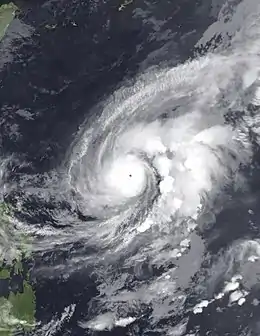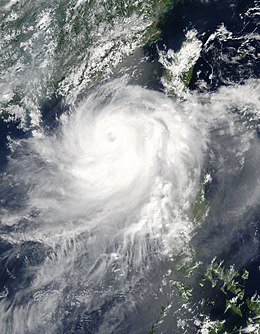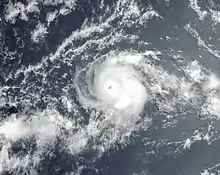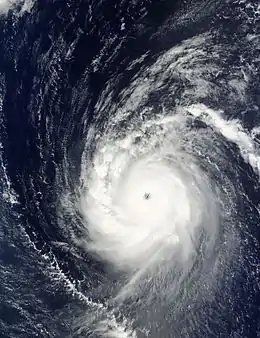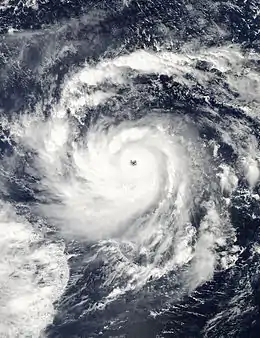Tropical cyclones in 2009
Throughout 2009, 130 tropical cyclones have formed in bodies of water known as tropical cyclone basins. Of these, 81 have been named, including a subtropical cyclone in the South Atlantic Ocean, by various weather agencies when they attained maximum sustained winds of 35 knots (65 km/h, 40 mph). The strongest storm of the year was Typhoon Nida in the Western Pacific Ocean. The deadliest and costliest storm of the year was Typhoon Morakot (Kiko) causing 789 fatalities through its track in the Philippines, Japan, Taiwan, China, and the Korean peninsula.
| Tropical cyclones in 2009 | |
|---|---|
 Year summary map | |
| Year boundaries | |
| First system | Auring |
| Formed | January 3, 2009 |
| Last system | 02U |
| Dissipated | January 6, 2010 |
| Strongest system | |
| Name | Nida |
| Lowest pressure | 905 mbar/hPa; 26.72 inHg |
| Longest lasting system | |
| Name | Parma |
| Duration | 17 days |
| Year statistics | |
| Total systems | 130 |
| Named systems | 81 |
| Total fatalities | 2,480 total |
| Total damage | $11.78 billion (2009 USD) |
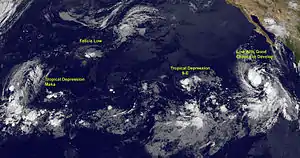
Tropical cyclones are primarily monitored by a group of ten warning centres, which have been designated as a Regional Specialized Meteorological Center (RSMC) or a Tropical Cyclone Warning Center (TCWC) by the World Meteorological Organization. These are the United States National Hurricane Center (NHC) and Central Pacific Hurricane Center, the Japan Meteorological Agency (JMA), the Indian Meteorological Department (IMD), Météo-France, Indonesia's Badan Meteorologi, Klimatologi, dan Geofisika, the Australian Bureau of Meteorology (BOM), Papua New Guinea's National Weather Service, the Fiji Meteorological Service (FMS) as well as New Zealand's MetService. Other notable warning centres include the Philippine Atmospheric, Geophysical and Astronomical Services Administration (PAGASA), the United States Joint Typhoon Warning Center (JTWC), and the Brazilian Navy Hydrographic Center.
Global atmospheric and hydrological conditions
The 2009–10 El Niño event started in the Pacific Ocean during May 2009, and it would peak in December of the year.[1]
Summary

North Atlantic Ocean
The North Atlantic featured a below-average event in tropical cyclone formation that produced only 11 tropical cyclones, 9 named storms, 3 hurricanes, and 2 major hurricanes. Like a typical Atlantic hurricane season, it officially began on Monday, June 1, 2009, and ended on Monday, November 30, 2009. These dates conventionally delimit the period of each year when most tropical cyclones develop in the Atlantic basin. Activity began slightly early when Tropical Depression One developed on May 28, marking the third and last consecutive season with a pre-season storm. The final storm, Hurricane Ida, dissipated on November 10. Hurricane Bill, the first hurricane, major hurricane, and most intense hurricane was a powerful Cape Verde-type hurricane that affected areas from the Leeward Islands to Newfoundland. With only 11 tropical depressions and 9 named storms, the 2009 season featured the lowest number of tropical cyclones since the 1997 season, and only one system, Claudette, made landfall in the United States. Forming from the interaction of a tropical wave and an upper-level low, Claudette made landfall on the Florida Panhandle with maximum sustained winds of 45 mph (75 km/h) before quickly dissipating over Alabama. The storm killed two people and caused $228,000 (2009 USD) in damage. Overall, the season's activity was reflected with a very low cumulative accumulated cyclone energy (ACE) rating of only 53, the lowest since 1997. Because of the low number of storms in the 2009 season, many of which were weak, short-lived, and/or very disorganized, the overall ACE value was ranked as below-average, totaling under 66. Being the most intense hurricane, Hurricane Bill was responsible for the ACE value for August being 30% above average. ACE is, broadly speaking, a measure of the power of the hurricane multiplied by the length of time it existed, so storms that last a long time, as well as particularly strong hurricanes, have high ACEs. ACE is only calculated for full advisories on tropical systems at or exceeding 34 knots (39 mph, 63 km/h) or tropical storm strength. Subtropical cyclones are excluded from the total.
Eastern & Central Pacific Oceans
The Eastern and Central Pacific featured their most active Pacific hurricane season since 1994. The season officially started on Friday, May 15, 2009 in the East Pacific Ocean, and on Monday, June 1, 2009 in the Central Pacific; they both ended on Monday, November 30, 2009. These dates conventionally delimit the period of each year when most tropical cyclones form in the Eastern and Central Pacific basins. However, the formation of tropical cyclones is possible at any time of the year. There were no off-season storms, as the season began relatively late, and ended very early. The Accumulated Cyclone Energy (ACE) index for the 2009 Pacific hurricane season was 117.09 units in the Eastern Pacific and 9.905 units in the Central Pacific. The total ACE in the basin combined is 126.995 units. Broadly speaking, ACE is a measure of the power of a tropical or subtropical storm multiplied by the length of time it existed. It is only calculated for full advisories on specific tropical and subtropical systems reaching or exceeding wind speeds of 39 mph (63 km/h). The season, however, was characterized as "near-normal", featuring 17 named storms 8 hurricanes and 5 major hurricanes. The central Pacific experienced above-average activity with three additional storms forming west of 140°W and three more crossing over from the eastern Pacific. The overall number of storms led to a relative lull in activity experienced over the previous decade. During the course of the year, large-scale factors such as an El Niño and two Madden–Julian oscillations greatly contributed to the changed pattern. The season's activity, east of 140°W, was reflected with a near-average cumulative accumulated cyclone energy (ACE) rating of 100, roughly 94% of the 30-year median. ACE, again, is, broadly speaking, a measure of the power of the hurricane multiplied by the length of time it existed, so storms that last a long time, as well as particularly strong hurricanes, have high ACEs. ACE is only calculated for full advisories on tropical systems at or exceeding 34 knots (39 mph, 63 km/h) or tropical storm strength.
Western Pacific Ocean
The Western Pacific featured a below average event that spawned only 22 named storms, 13 typhoons, and five super typhoons. It was also recognized as the deadliest season in the Philippines for decades. The first half of the season was very quiet whereas the second half of the season was extremely active. The season's first named storm, Kujira, developed on May 3 while the season's last named storm, Nida, dissipated on December 3. Nida was the most intense of the whole year worldwide.
North Indian Ocean
The North Indian Ocean featured a generally below average event in the annual cycle of tropical cyclone formation. It featured 8 depressions, 6 deep depressions, 4 cyclonic storms, and 1 severe cyclonic storm. No classifications higher. The North Indian Ocean cyclone season has no official bounds, but cyclones tend to form between April and December, with peaks in May and November. These dates conventionally delimit the period of each year when most tropical cyclones form in the northern Indian Ocean.
Systems
There have been 128 tropical disturbances that have formed in 2009, marking an above-average year in tropical cyclone formation throughout the world. One was believed to have formed in the South Atlantic Ocean in late January, and was unofficially added in the 2009 advisories. 82 further intensified to tropical storms, and each received named from each tropical cyclone agency.
January
During January 2009, a total of 14 tropical cyclones formed, while 8 were named. The Cyclone Fanele was the most intense of the month, reaching category 4 on the SSHWS scale, and a bariometric pressure of 930 mbar. The other storms were relatively weak, with a force equivalent to a tropical storm. A rare subtropical system has been reported in the southern Atlantic, affecting the southern cosats of Brazil and Uruguai. no major damage or death has been reported.
| Storm name | Dates active | Max wind km/h (mph) |
Pressure (hPa) |
Areas affected | Damage (USD) |
Deaths | Refs |
|---|---|---|---|---|---|---|---|
| Auring | January 3 – 6 | 45 (30) | 1006 | Philippines | $498 thousand | 2 | |
| 04F | January 4 – 14 | Unspecified | 1001 | Fiji | $64.2 million | 12 | |
| Dongo | January 7 – 12 | 95 (60) | 984 | None | None | None | |
| Charlotte | January 10 – 12 | 85 (50) | 986 | Northern Territory, Cape York Peninsula | $15 million | None | |
| 05F | January 11 – 14 | Unspecified | 999 | None | None | None | |
| 07U | January 11 – 12 | 35 (25) | 1000 | None | None | None | |
| Eric | January 16 – 22 | 95 (60) | 991 | Madagascar | Minimal | 2 | |
| Fanele | January 17 – 22 | 185 (115) | 930 | Madagascar | Unknown | 10 | |
| 06F | January 19 – 23 | Unspecified | 1005 | None | None | None | |
| 07F | January 23 – 25 | Unspecified | 1006 | None | None | None | |
| Hettie | January 24 – 31 | 65 (40) | 995 | None | None | None | |
| Dominic | January 24 – 27 | 100 (65) | 976 | Kimberley, Pilbara | Unknown | None | |
| 01Q | January 29 – February 1 | Unspecified | Unspecified | Brazil (Rio de Janeiro), Uruguay | Unknown | Unknown | |
| Ellie | January 30 – February 4 | 75 (45) | 988 | Cape York | $69.5 million | None |
February
February was moderately active
| Storm name | Dates active | Max wind km/h (mph) |
Pressure (hPa) |
Areas affected | Damage (USD) |
Deaths | Refs |
|---|---|---|---|---|---|---|---|
| Gael | February 1 – 9 | 185 (115) | 930 | Madagascar | Unknown | 2 | |
| 09F | February 1 – 5 | 55 (35) | 998 | New Caledonia | Unknown | Unknown | |
| Freddy | February 3 – 13 | 85 (50) | 992 | None | None | None | |
| 11U | February 4 – 6 | Unspecified | Unspecified | None | None | None | |
| 12U | February 11 – 17 | <35 (<25) | Unspecified | Western Australia | Unknown | None | |
| Bising | February 12 – 13 | 45 (30) | 1002 | Philippines | None | None | |
| Innis | February 13 – 18 | 75 (45) | 990 | Vanuatu, New Caledonia | Minimal | 1 | |
| 14U | February 23 – March 2 | <35 (<25) | Unspecified | Western Australia | Unknown | None | |
| Hina | February 20 – 26 | 105 (65) | 976 | None | None | None | |
| Gabrielle | February 27 – March 6 | 65 (40) | 996 | None | None | None |
March
March was moderately active
| Storm name | Dates active | Max wind km/h (mph) |
Pressure (hPa) |
Areas affected | Damage (USD) |
Deaths | Refs |
|---|---|---|---|---|---|---|---|
| Hamish | March 4 – 11 | 215 (130) | 924 | Queensland | $38.8 million | 2 | |
| 10 | March 6 – 10 | 55 (35) | 997 | None | None | None | |
| Joni | March 10 – 14 | 95 (60) | 980 | Cook Islands | Minor | Unknown | |
| Ilsa | March 12 – 27 | 165 (105) | 958 | None | None | None | |
| Ken | March 16 – 19 | 95 (60) | 985 | None | Unknown | None | |
| 19U | March 16 – 20 | 45 (30) | 999 | None | None | None | |
| Izilda | March 22 – 27 | 110 (70) | 978 | None | None | None | |
| Jasper | March 22 – 30 | 100 (60) | 980 | New Caledonia | Minimal | None | |
| 21U | March 23 – 31 | 55 (35) | 1002 | None | None | None | |
| Lin | March 31 – April 7 | 110 (70) | 975 | Fiji, Tonga | $920 thousand | None |
April
April was relatively inactive,
| Storm name | Dates active | Max wind km/h (mph) |
Pressure (hPa) |
Areas affected | Damage (USD) |
Deaths | Refs |
|---|---|---|---|---|---|---|---|
| Jade | April 3 – 10 | 110 (70) | 975 | Madagascar | Unknown | 15 | |
| 15F | April 7 – 10 | 35 (25) | 1004 | None | None | None | |
| 22U | April 4 – 11 | 35 (25) | 1004 | None | None | None | |
| Bijli | April 14 – 17 | 75 (45) | 996 | Eastern India, Bangladesh, Myanmar | Unknown | 3 | |
| Kirrily | April 18 – May 1 | 65 (40) | 999 | Indonesia | Minimal | None | |
| Crising | April 30 – May 1 | 55 (35) | Unspecified | Philippines | None | None |
May
May was relatively inactive,
| Storm name | Dates active | Max wind km/h (mph) |
Pressure (hPa) |
Areas affected | Damage (USD) |
Deaths | Refs |
|---|---|---|---|---|---|---|---|
| Kujira (Dante) | May 1 – 7 | 155 (100) | 940 | Philippines, Russian Far East | $27 million | 28 | |
| TD | May 1 – 4 | 55 (35) | 1004 | None | None | None | |
| Chan-hom (Emong) | May 2 – 9 | 120 (75) | 975 | Vietnam, Philippines, Ryukyu Islands | $26.1 million | 60 | |
| 24U | May 10 – 18 | 35 (25) | 1009 | None | None | None | |
| Aila | May 23 – 26 | 110 (70) | 968 | India, Bangladesh | $553 million | 330 | |
| One | May 28 – 29 | 55 (35) | 1006 | North Carolina | None | None | [2] |
June
June was relatively inactive with six tropical cyclones and three tropical storm-equivalent cyclones forming. Hurricane Andres gave the 2009 Pacific hurricane season a late start when it formed on June 21 (the latest start on record until the record was beaten exactly a decade later when Alvin formed on June 25, 2019).
| Storm name | Dates active | Max wind km/h (mph) |
Pressure (hPa) |
Areas affected | Damage (USD) |
Deaths | Refs |
|---|---|---|---|---|---|---|---|
| Linfa | June 14 – 22 | 110 (70) | 975 | Philippines, Taiwan, China | $105 million | 7 | |
| One-E | June 18 – 19 | 55 (35) | 1003 | Western Mexico, Northwest Mexico | Unknown | None | [3] |
| Andres | June 21 – 24 | 130 (80) | 984 | Southwestern Mexico, Western Mexico, Honduras | $2.31 thousand | 3, 2 indirect | [4] |
| Nangka (Ferio) | June 22 – 27 | 75 (45) | 994 | Philippines, China | $54 thousand | 6 | |
| ARB 01 | June 23 – 24 | 45 (30) | 998 | India | Unknown | 9 | |
| ARB 02 | June 25 – 26 | 45 (30) | 998 | India | Unknown | None |
July
July was slightly inactive in terms of intensity per tropical cyclones, and slightly active in terms of number of tropical cyclones that formed, with nine. Seven were tropical storm equivalent, and only two were hurricane or typhoon equivalent tropical cyclones. No majors. Although Hurricane Carlos was the most intense of the month, none of the tropical cyclones caused any form of severe destruction. Over 50 people were killed, however, a deadly exception.
| Storm name | Dates active | Max wind km/h (mph) |
Pressure (hPa) |
Areas affected | Damage (USD) |
Deaths | Refs |
|---|---|---|---|---|---|---|---|
| Blanca | July 6 – 9 | 85 (50) | 998 | Western Mexico, California | Unknown | None | [5] |
| Souledor (Gorio) | July 9 – 13 | 65 (40) | 992 | Philippines, China, Vietnam | $9 million | 19 | |
| Carlos | July 10 – 16 | 165 (105) | 971 | None | None | None | [6] |
| 06W (Huaning) | July 11 – 14 | 55 (35) | 1000 | Taiwan, China | None | None | |
| Dolores | July 15 – 16 | 95 (60) | 997 | None | None | None | [7] |
| Molave (Isang) | July 15 – 19 | 120 (75) | 975 | Philippines, Taiwan, China | Moderate | 4 | |
| BOB 03 | July 20 – 21 | 55 (35) | 988 | India | Unknown | 43 | |
| Lana | July 30 – August 2 | 100 (65) | 995 | None | None | None | [8] |
| Goni (Jolina) | July 30 – August 9 | 75 (45) | 988 | Philippines, China, Vietnam | Minor | 8 |
August
August was the most active month the year that 21 tropical cyclones formed throughout the world. 16 attained sustained wind speeds of 64 km/h (39 mph) or greater. Tropical Storm Ana became the first named storm of the very inactive 2009 Atlantic hurricane season, when it formed on August 11, one of that latest first named storms on record since Alex of 2004. Typhoon Morakot (Kiko) was the deadliest tropical cyclone of the year, killing 789 total. Hurricane Jimena became the most intense of the month in the latter portion of August.
| Storm name | Dates active | Max wind km/h (mph) |
Pressure (hPa) |
Areas affected | Damage (USD) |
Deaths | Refs |
|---|---|---|---|---|---|---|---|
| Morakot (Kiko) | August 2 – 11 | 140 (85) | 945 | Philippines, Japan, Taiwan, China, Korea | $6.2 billion | 789 | |
| Enrique | August 3 – 7 | 100 (65) | 994 | None | None | None | [9] |
| Felicia | August 3 – 11 | 230 (145) | 935 | Hawaii | Minimal | None | [10] |
| Etau | August 8 – 14 | 75 (45) | 992 | Japan | $87.5 million | 28 | |
| Nine-E | August 9 – 11 | 55 (35) | 1006 | None | None | None | [11] |
| Ana | August 11 – 16 | 65 (40) | 1003 | Lesser Antilles, Puerto Rico, Hispaniola, Cuba, The Bahamas | Minimal | None | [12] |
| Maka | August 11 – 18 | 65 (40) | 1006 | None | None | None | [13] |
| Guillermo | August 12 – 19 | 205 (125) | 954 | Hawaii | None | None | [14] |
| Bill | August 15 – 24 | 215 (130) | 943 | Leeward Islands, Puerto Rico, Hispaniola, United States East Coast, BermudaAtlantic Canada (Newfoundland), British Isles | $46.2 million | 2 | [15] |
| Claudette | August 16 – 18 | 95 (60) | 1005 | Southeastern United States (Florida) | $350,000 | 2 | [16] |
| Vamco | August 16 – 26 | 165 (105) | 945 | None | None | None | |
| 01 | August 18 – 20 | 35 (20) | 1004 | None | None | None | |
| TD | August 20 – 21 | 55 (35) | 1002 | Japan | None | None | |
| Hilda | August 22 – 28 | 100 (65) | 995 | None | None | None | [17] |
| Ignacio | August 24 – 27 | 85 (50) | 999 | None | None | None | [18] |
| TD | August 25 – 27 | 55 (35) | 1004 | None | None | None | |
| Danny | August 26 – 29 | 95 (60) | 1006 | North Carolina, Northeastern United States, Atlantic Canada | Minimal | 1 | [19] |
| Jimena | August 28 – September 4 | 250 (155) | 931 | Western Mexico, Northwest Mexico (Baja California Sur), Southwestern United States | $211 million | 5, 2 indirect | [20] |
| Two-C | August 28 – September 2 | 55 (35) | 1004 | None | None | None | [21] |
| Krovanh | August 28 – September 1 | 110 (70) | 975 | Japan | None | None | |
| Kevin | August 29 – September 1 | 85 (50) | 1000 | None | None | None | [22] |
September
September was the second-most active of the year.
| Storm name | Dates active | Max wind km/h (mph) |
Pressure (hPa) |
Areas affected | Damage (USD) |
Deaths | Refs |
|---|---|---|---|---|---|---|---|
| Erika | September 1 – 3 | 85 (50) | 1004 | Lesser Antilles, Puerto Rico, Dominican Republic | $35,000 | None | [23] |
| Dujuan (Labuyo) | September 1 – 10 | 95 (60) | 980 | Mariana Islands | None | None | |
| TD | September 3 – 9 | 45 (30) | 1000 | Vietnam | $2.52 million | 6 | |
| BOB 04 | September 5 – 7 | 55 (35) | 990 | India (West Bengal) | Unknown | 1 | |
| Fred | September 7 – 12 | 195 (120) | 958 | Cape Verde | None | None | [24] |
| Linda | September 7 – 11 | 130 (80) | 985 | None | None | None | [25] |
| Mujigae (Maring) | September 8 – 12 | 75 (45) | 990 | Philippines, China, Vietnam | $14.6 million | 11 | |
| Koppu (Nando) | September 12 – 16 | 120 (75) | 975 | Philippines, China | Moderate | None | |
| Choi-wan | September 12 – 20 | 195 (120) | 915 | Mariana Islands | Minor | None | |
| Marty | September 16 – 19 | 75 (45) | 1002 | None | None | None | [26] |
| 02 | September 18 – 20 | 35 (20) | 1008 | None | None | None | |
| Nora | September 23 – 25 | 95 (60) | 997 | None | None | None | [27] |
| TD | September 23 – 26 | 45 (30) | 1006 | Mariana Islands | Minor | None | |
| Eight | September 25 – 26 | 55 (35) | 1008 | None | None | None | [28] |
| Ketsana (Ondoy) | September 25 – 30 | 130 (80) | 960 | Philippines, Vietnam, Laos, Cambodia, Thailand | $1.09 billion | 710 | |
| 18W | September 26 – 30 | 55 (30) | 1000 | Mariana Islands, Caroline Islands | None | None | |
| Parma (Pepeng) | September 27 – October 14 | 185 (115) | 930 | Caroline Islands, Philippines, Taiwan, China, Vietnam | $662 million | 500 | |
| Melor (Quedan) | September 29 – October 8 | 205 (125) | 910 | Caroline Islands, Mariana Islands, Japan | $1.5 billion | 3 |
October
October was inactive in terms of tropical cyclones, but it was slightly active in terms of intensity in hPa/mbar., especially towards the end of the month. 10 tropical cyclones formed in October 2009. 9 of those attained storm intensities and were named. Hurricane Rick was the third-most intense Pacific hurricane on record, as well as the second-most intense of 2009 worldwide. The 2009 Pacific hurricane season ended slightly earlier than usual when Hurricane Neki dissipated on October 27
| Storm name | Dates active | Max wind km/h (mph) |
Pressure (hPa) |
Areas affected | Damage (USD) |
Deaths | Refs |
|---|---|---|---|---|---|---|---|
| Olaf | October 1 – 3 | 75 (45) | 996 | Baja California Peninsula | None | None | [29] |
| Grace | October 4 – 6 | 100 (85) | 986 | Azores, Portugal, British Isles | Minimal | None | [30] |
| Henri | October 6 – 8 | 85 (50) | 1005 | Lesser Antilles, Greater Antilles | None | None | [31] |
| Nepartak | October 8 – 13 | 85 (50) | 992 | Mariana Islands | None | None | |
| Patricia | October 11 – 14 | 95 (60) | 996 | Baja California Peninsula, Northwest Mexico | None | None | [32] |
| Lupit (Ramil) | October 14 – 27 | 175 (110) | 930 | Caroline Islands, Philippines, Japan | Minor | None | |
| Rick | October 15 – 21 | 285 (180) | 906 | Western Mexico (Sinaloa), Northwest Mexico, Southern United States | $14.6 million | 3, 1 indirect | [33] |
| TD | October 16 – 20 | 45 (30) | 1002 | Vietnam, China | None | None | |
| Neki | October 18 – 27 | 205 (125) | 950 | Hawaii | None | None | [34] |
| Mirinae (Santi) | October 25 – November 3 | 150 (90) | 955 | Caroline Islands, Mariana Islands, Philippines, Vietnam, Cambodia, Laos, Thailand | $295 million | 162 |
November
November was relatively inactive with only 10 tropical cyclones forming and 5 attaining tropical storm intensities. The inactive 2009 Atlantic hurricane season ended when Hurricane Ida dissipated on November 10 (it transitioned to a Nor'easter just after, so it ended when "Nor'Ida" dissipated) Despite two tropical disturbances forming in August and September, the 2009-10 South-West Indian Ocean cyclone season actually didn't see a named tropical storm form until November 13. The start to the season was pretty intense when Cyclone Anja peaked at 950 hPa. Typhoon Nida was the most intense of the year, peaking at a pressure of 905 hPa, just ahead of Hurricane Rick of the previous month.
| Storm name | Dates active | Max wind km/h (mph) |
Pressure (hPa) |
Areas affected | Damage (USD) |
Deaths | Refs |
|---|---|---|---|---|---|---|---|
| 24W (Tino) | November 1 – 2 | 55 (35) | 1006 | Philippines | None | None | |
| Ida | November 4 – 10 | 165 (105) | 975 | Central America (Nicaragua), Cayman Islands, Yucatán Peninsula, Cuba, Southeastern United States | $11.4 million | 4 | [35] |
| Phyan | November 9 – 12 | 85 (50) | 988 | India | $64.9 million | 28 | |
| 25W | November 7 – 10 | 55 (35) | 1000 | None | None | None | |
| 03 | November 7 – 10 | 45 (30) | 1002 | None | None | None | |
| Anja | November 13 – 18 | 165 (105) | 950 | None | None | None | |
| Bongani | November 22 – 25 | 75 (45) | 997 | Madagascar | None | None | |
| 27W (Urduja) | November 21 – 24 | 55 (35) | 1002 | Philippines | Minor | 4 | |
| Nida (Vinta) | November 21 – December 3 | 215 (130) | 905 | Caroline Islands, Mariana Islands | Minor | None | |
| TD | November 24 – 25 | 55 (35) | 1006 | Malaysia, Indonesia, Thailand | None | None |
December
December was relatively and slightly inactive
| Storm name | Dates active | Max wind km/h (mph) |
Pressure (hPa) |
Areas affected | Damage (USD) |
Deaths | Refs |
|---|---|---|---|---|---|---|---|
| 28W | December 3 – 5 | 45 (30) | 1000 | None | None | None | |
| Cleo | December 6 – 14 | 195 (120) | 930 | None | None | None | |
| Mick | December 3 – 15 | 110 (70) | 975 | Fiji | $33 million | 3 | |
| 02F | December 6 – 12 | Unspecified | 1003 | None | None | None | |
| TD | December 7 – 8 | 45 (30) | 1008 | Philippines | None | None | |
| Laurence | December 8 – 23 | 205 (125) | 925 | Northern Territory, Western Australia | $9 million | None | |
| Ward | December 10 – 16 | 85 (50) | 996 | Sri Lanka, India | Unknown | None | |
| David | December 12 – 25 | 85 (50) | 987 | Reunion, Mauritius, Madagascar | None | None | |
| 02U | December 27 – January 6, 2010 | 45 km/h (30 mph) | 1000 | Northern Territory | Unknown | None |
Global effects
- The sum of the number of systems and fatalities in each basin will not equal the number shown as the total. This is because when systems move between basins, it creates a discrepancy in the actual number of systems and fatalities.
Notes
1 Only systems that formed either on or after January 1, 2009 are counted in the seasonal totals.
2 Only systems that formed either before or on December 31, 2009 are counted in the seasonal totals.
3 The wind speeds for this tropical cyclone/basin are based on the IMD Scale which uses 3-minute sustained winds.
4 The wind speeds for this tropical cyclone/basin are based on the Saffir Simpson Scale which uses 1-minute sustained winds.
5The wind speeds for this tropical cyclone are based on Météo-France which uses gust winds.
References
- "Historical El Niño/La Niña episodes (1950–present)". United States Climate Prediction Center. 4 November 2015. Retrieved 10 January 2015.
- Berg, Robbie (12 June 2009). "Tropical Cyclone Report: Tropical Depression One (AL012009)" (PDF). National Hurricane Center.
- Blake, Eric S. (July 31, 2009). "Tropical Cyclone Report: Tropical Depression One-E (EP012009)" (PDF). National Hurricane Center.
- Brown, Daniel P. (July 21, 2009). "Tropical Cyclone Report: Hurricane Andres (EP022009)" (PDF). National Hurricane Center.
- Pasch, Richard J. (November 23, 2009). "Tropical Cyclone Report: Tropical Storm Blanca (EP032009)" (PDF). National Hurricane Center.
- Avila, Lixion A. (September 22, 2009). "Tropical Cyclone Report: Hurricane Carlos (EP042009)" (PDF). National Hurricane Center.
- Beven II, John L. (January 15, 2010). "Tropical Cyclone Report: Tropical Storm Dolores (EP052009)" (PDF). National Hurricane Center.
- Birchard, Thomas; Knabb, Richard D.; Brennan, Michael J. (February 17, 2010). "Tropical Cyclone Report: Tropical Storm Lana (EP062009)" (PDF). Central Pacific Hurricane Center; National Hurricane Center.
- Berg, Robbie (September 21, 2009). "Tropical Cyclone Report: Tropical Storm Enrique (EP072009)" (PDF). National Hurricane Center.
- Kimberlain, Todd B.; Wroe, Derek; Knabb, Richard D. (January 14, 2010). "Tropical Cyclone Report: Hurricane Felicia (EP082009)" (PDF). National Hurricane Center; Central Pacific Hurricane Center.
- Brown, Daniel P. (September 22, 2009). "Tropical Cyclone Report: Tropical Depression Nine-E (EP092009)" (PDF). National Hurricane Center.
- Blake, Eric S. (September 26, 2009). "Tropical Cyclone Report: Tropical Storm Ana (AL022009)" (PDF). National Hurricane Center.
- Craig, Timothy A. (November 15, 2009). "Tropical Cyclone Report: Tropical Storm Maka (CP012009)" (PDF). Central Pacific Hurricane Center.
- Blake, Eric S.; Houston, Sam; Knabb, Richard D. (February 10, 2010). "Tropical Cyclone Report: Hurricane Guillermo (EP102009)" (PDF). National Hurricane Center; Central Pacific Hurricane Center.
- Avila, Lixion A. (October 21, 2009). "Tropical Cyclone Report: Hurricane Bill (AL032009)" (PDF). National Hurricane Center.
- Pasch, Richard J. (January 5, 2010). "Tropical Cyclone Report: Tropical Storm Claudette (AL042009)" (PDF). National Hurricane Center.
- Pasch, Richard J.; Knabb, Richard D.; Powell, Jeffrey (February 10, 2010). "Tropical Cyclone Report: Tropical Storm Hilda (EP112009)" (PDF). National Hurricane Center; Central Pacific Hurricane Center.
- Avila, Lixion A. (October 28, 2009). "Tropical Cyclone Report: Tropical Storm Ignacio (EP122009)" (PDF). National Hurricane Center.
- Beven II, John L. (January 6, 2010). "Tropical Cyclone Report: Tropical Storm Danny (AL052009)" (PDF). National Hurricane Center.
- Beven, John L. (January 29, 2010). "Tropical Cyclone Report: Hurricane Jimena (EP132009)" (PDF). National Hurricane Center.
- Birchard, Thomas; Kodama, Kevin; Tanabe, Raymond; Fukada, Ed (May 13, 2010). "Tropical Cyclone Report: Tropical Depression Two-C (CP022009)" (PDF). Central Pacific Hurricane Center; Joint Typhoon Warning Center.
- Brennan, Michael J. (September 24, 2009). "Tropical Cyclone Report: Tropical Storm Kevin (EP142009)" (PDF). National Hurricane Center.
- Brown, Daniel P. (October 29, 2009). "Tropical Cyclone Report: Tropical Storm Erika (AL062009)" (PDF). National Hurricane Center.
- Brennan, Michael J. (October 23, 2009). "Tropical Cyclone Report: Hurricane Fred (AL072009)" (PDF). National Hurricane Center.
- Berg, Robbie (October 26, 2009). "Tropical Cyclone Report: Hurricane Linda (EP152009)" (PDF). National Hurricane Center.
- Kimberlain, Todd B. (November 17, 2009). "Tropical Cyclone Report: Tropical Storm Marty (EP162009)" (PDF). National Hurricane Center.
- Cangialosi, John P.; Brown, Daniel P. (November 7, 2009). "Tropical Cyclone Report: Tropical Storm Nora (EP172009)" (PDF). National Hurricane Center.
- Kimberlain, Todd B. (October 23, 2009). "Tropical Cyclone Report: Tropical Depression Eight (AL082009)" (PDF). National Hurricane Center.
- Blake, Eric S. (November 11, 2009). "Tropical Cyclone Report: Tropical Storm Olaf (EP182009)" (PDF). National Hurricane Center.
- Berg, Robbie (November 23, 2009). "Tropical Cyclone Report: Tropical Storm Grace (AL092009)" (PDF). National Hurricane Center.
- Blake, Eric S. (November 17, 2009). "Tropical Cyclone Report: Tropical Storm Henri (AL102009)" (PDF). National Hurricane Center.
- Landsea, Christopher W.; Pasch, Richard J. (November 10, 2009). "Tropical Cyclone Report: Tropical Storm Patricia (EP192009)" (PDF). National Hurricane Center.
- Cangialosi, John P.; Avila, Lixion A. (December 3, 2009). "Tropical Cyclone Report: Hurricane Rick (EP202009)" (PDF). National Hurricane Center.
- Wroe, Derek (February 5, 2010). "Tropical Cyclone Report: Hurricane Neki (CP032009)" (PDF). Central Pacific Hurricane Center.
- Avila, Lixion A.; Cangialosi, John (January 14, 2010). "Tropical Cyclone Report: Hurricane Ida (AL112009)" (PDF). National Hurricane Center.
External links
| Tropical cyclone year articles (2000–2009) |
|---|
| 2000, 2001, 2002, 2003, 2004, 2005, 2006, 2007, 2008, 2009 |
Regional Specialized Meteorological Centers
- US National Hurricane Center – North Atlantic, Eastern Pacific
- Central Pacific Hurricane Center – Central Pacific
- Japan Meteorological Agency – NW Pacific
- India Meteorological Department – Bay of Bengal and the Arabian Sea
- Météo-France – La Reunion – South Indian Ocean from 30°E to 90°E
- Fiji Meteorological Service – South Pacific west of 160°E, north of 25° S
Tropical Cyclone Warning Centers
- Meteorology, Climatology, and Geophysical Agency of Indonesia – South Indian Ocean from 90°E to 141°E, generally north of 10°S
- Australian Bureau of Meteorology (TCWC's Perth, Darwin & Brisbane) – South Indian Ocean & South Pacific Ocean from 90°E to 160°E, generally south of 10°S
- Papua New Guinea National Weather Service – South Pacific Ocean from 141°E to 160°E, generally north of 10°S
- Meteorological Service of New Zealand Limited – South Pacific west of 160°E, south of 25°S
![]() This article incorporates public domain material from websites or documents of the National Weather Service.
This article incorporates public domain material from websites or documents of the National Weather Service.




